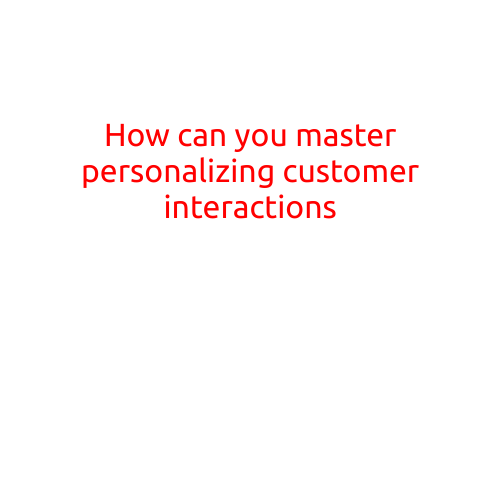
How Can You Master Personalizing Customer Interactions?
In today’s digital age, personalization has become a crucial aspect of customer service. With the abundance of data at our fingertips, it’s easier than ever to tailor interactions to individual customers’ preferences, needs, and behaviors. However, mastering personalization requires more than just having the right tools and technology. It demands a deep understanding of your customers, a willingness to listen and adapt, and a commitment to continuous improvement.
Know Your Customer Inside Out
Before you can personalize customer interactions, you need to have a comprehensive understanding of who your customers are, what they want, and what drives them. This involves gathering data from various sources, such as customer feedback, purchase history, and social media engagement. You should also conduct regular surveys and focus groups to stay informed about changes in your customers’ preferences and behaviors.
Use Data-Driven Insights to Inform Personalization
Armed with relevant data, you can use various tools and technologies to personalize customer interactions. For example, machine learning algorithms can analyze customer behavior and predict their preferences, allowing you to offer targeted recommendations and promotions. Other tools, such as customer relationship management (CRM) software, can help you manage customer relationships and deliver personalized content.
Create a Personalized Experience Across All Touchpoints
Personalization is not just about the initial interaction, but about creating a cohesive and consistent experience across all touchpoints, including your website, social media, email, and physical store. This requires coordinating efforts across different teams and channels, ensuring that every interaction is personalized and customer-centric.
Deliver Relevant and Timely Content
Customers expect relevant and timely content that resonates with their interests and needs. To deliver this, you should segment your audience and create targeted content that speaks to each group’s unique preferences and concerns. This could include sending personalized promotional emails, offering exclusive deals to loyalty program members, or sharing relevant social media content.
Leverage Storytelling to Build Emotional Connections
Personalization is not just about delivering relevant content, but also about creating emotional connections with your customers. Storytelling is an effective way to build empathy and trust with your audience, making them more likely to engage with your brand and return as customers. Use customer testimonials, behind-the-scenes stories, and employee spotlights to humanize your brand and create a sense of community.
Measure and Refine Your Personalization Strategy
To ensure that your personalization efforts are paying off, you need to measure and analyze the results. Track key metrics, such as conversion rates, customer retention, and Net Promoter Score (NPS), to gauge the effectiveness of your personalization strategy. Use these insights to refine and optimize your approach, making adjustments as needed to deliver a more personalized experience.
Conclusion
Mastering personalization requires a commitment to understanding your customers, leveraging data-driven insights, and delivering a cohesive and consistent experience across all touchpoints. By using storytelling to build emotional connections, measuring and refining your strategy, and staying customer-centric, you can create a personalization approach that drives loyalty, engagement, and ultimately, revenue.





